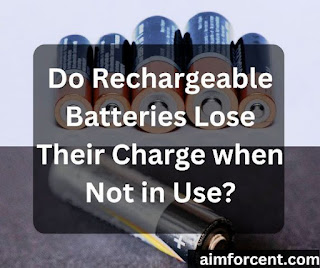How Many Hours Do Rechargeable Batteries Last Per Charge?
Rechargeable batteries are an eco-friendly and cost-effective solution to power our electronic devices. However, their lifespan depends on various factors such as the type of battery, usage pattern, and charging method. In this blog, I am going to tell you how many hours rechargeable batteries last per charge and the factors that affect their lifespan. Please continue reading:
First, it is important to understand a few aspects of rechargeable batteries:
Interesting Facts of Rechargeable Batteries
- echargeable batteries are made up of one or more cells that store electrical energy.
- There are different types of rechargeable batteries available in the market, such as nickel-cadmium (Ni-Cd), nickel-metal hydride (Ni-MH), and lithium-ion (Li-ion).
- All these batteries have their own advantages and disadvantages.
Nickel-Cadmium (Ni-Cd) Batteries
Nickel-Cadmium (Ni-Cd) batteries were once the most common type of rechargeable battery in the market. Usually, they have a high discharge rate, which makes them suitable for high-drain devices such as power tools and remote-controlled cars. However, they have a lower energy density compared to other rechargeable batteries and suffer from the “memory effect” if they are not discharged fully before recharging.
Nickel-Metal Hydride (Ni-MH) Batteries
Nickel-Metal Hydride (Ni-MH) batteries have a higher energy density compared to Ni-Cd batteries, making them more suitable for portable devices such as cameras and mobile phones. They are also less susceptible to the memory effect and have a longer lifespan.
Lithium-Ion (Li-ion) Batteries
Lithium-Ion (Li-ion) batteries are the most common type of rechargeable battery used in modern electronic devices such as laptops, smartphones, and tablets. They have a higher energy density compared to Ni-MH batteries and are lightweight, making them ideal for portable devices. They are also less prone to the memory effect and have a longer lifespan.
Read Similar Posts:
Can You Replace a Rechargeable Battery with a Regular Battery?
How Many Times Can You Recharge a Rechargeable Battery?
How Many Hours Do Rechargeable Batteries Last Per Charge?
On average, rechargeable batteries last from a few hours to several days per charge, depending on the device and usage pattern.
The lifespan of rechargeable batteries depends on various factors such as usage patterns, charging method, and the type of battery.
For example, a Ni-Cd battery used in a power tool can last for a few hours per charge, while a Li-ion battery used in a smartphone can last for a day or more per charge.
Ni-MH batteries can last for up to 12 hours per charge, while Li-ion batteries can last for up to 24 hours or more, depending on the device and usage pattern.
Now, you have the direct answer. It is interesting to understand the factors that affect the battery lifespan.
5 Factors that Affect the Lifespan of Rechargeable Batteries
I am going to tell you some facts that affect the battery performance, but it depends on the type of battery you are using.
Usage Pattern
The lifespan of rechargeable batteries depends on the usage pattern. If a device is used continuously for a long time, the battery will drain quickly. On the other hand, if the device is used intermittently, the battery lifespan will be longer.
Charging Method
The charging method also affects the lifespan of rechargeable batteries. Overcharging or undercharging the battery causes damage to the battery and reduces its lifespan. It is recommended to use the original charger provided by the manufacturer and avoid using third-party chargers. For example, many users often use third-party chargers for smartphone, tablet, and laptop charging, but you should not do it!
Storage Conditions
The storage conditions also play a crucial role in the lifespan of rechargeable batteries. Extreme temperatures, such as high heat or cold, damage the battery. It is recommended to store the battery at room temperature and avoid exposing it to extreme temperatures.
Number of Charge Cycles
Rechargeable batteries have a limited number of charge cycles, after which their capacity to hold a charge decreases. The number of charge cycles varies depending on the type of battery. For example, Ni-Cd batteries last for up to 500-1000 charge cycles, while Li-ion batteries last for up to 500-1000 charge cycles.
Age of the Battery
The age of the battery also affects its lifespan. Over time, the battery capacity decreases, and the battery lifespan reduces. It is recommended to replace the battery if it is more than two years old or if its capacity has reduced significantly.
Now you have understood the factors that determine the lifespan of your rechargeable battery. Indeed, you cannot control some of the factors. Most brands are now focusing on rechargeable Li-ion batteries for electronic devices and gadgets. Always use a battery that is compatible with your devices, and consult an expert if you cannot find such batteries.
Are you going to use regular batteries instead of rechargeable ones? Please read this post:
How Long Does a 650 mAh Battery Take to Charge?
Meet Rohan, a writer who loves to inspire and motivate others. He’s all about those feel-good quotes that can light up your day! When he’s not crafting words of encouragement, Rohan dives into the world of the latest technologies, exploring what’s new and exciting. But that’s not all—his heart beats for solar products, the kind that harness the power of the sun for a greener future. And guess what? He’s a total pet lover too! When he’s not busy writing, you’ll find Rohan surrounded by his furry friends, spreading joy and cuddles all around. Follow Rohan on Twitter and Facebook







